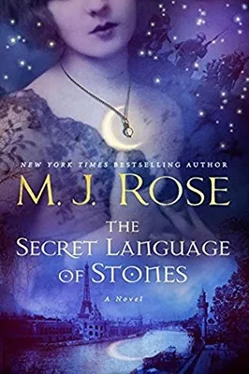Tying my robe around my waist, I went out into the hall and followed the sound. When I reached the end of the corridor, it grew fainter. I retraced my steps. The hallway was dark and the house otherwise silent. Only the forlorn crying echoed. Concentrating, I tried to locate its direction. Was it coming from above? I climbed the steps to the third floor.
Yes, the sound was more pronounced. I walked down another long hallway, past rooms used by servants. At its end, in front of another staircase, I stopped to listen again. It seemed the weeping was still coming from above. Was that possible? Were soldiers sleeping even in the attic?
I followed the crying through a warren of storage rooms and a last ancient stone staircase leading to the bell tower, the one remaining structure from the sixteenth-century church that had once stood on this plot of land. This was where, in the late 1500s and early 1600s, my ancestor, the famous courtesan La Lune, entertained her paramours, including the king of France and the famous painter Cherubino Cellini, the man for whom she learned the dark arts in order to regain his love. After he died, she became a celebrated artist herself and lived, according to the family legend, into the 1700s while retaining the appearance of a forty-year-old woman.
As a little girl visiting, I’d been drawn to this very staircase. I would ask if I could go up and see the bell tower, but my great-grandmother insisted it wasn’t safe. Too old and too fragile to hold the weight of a person.
“The steps are broken, and you could trip. Inside the tower is only scaffolding now,” she’d warned. “If you even tried to walk there, you would fall right through!”
My mother, overhearing this, would laugh.
“But what is funny, Maman?” I asked. “It sounds dangerous, no?”
“Your great-grandmother told me the same thing once upon a time. And I believed her too. But it’s not true. You should see what is up there, it’s part of your heritage.”
Over my great-grandmother’s protestations, my mother took me up the last flight of steps. Yes, they were narrow and steep, but also sturdy and strong. My mother told me three hundred years of bell ringers had tramped up and down them and the tower they led to was constructed just as well.
At the top of the steps was a door carved with tiny bas-reliefs, each detailing an alchemical event and other amalgams of magick and religious symbols sprinkled through the rest of the house.
I tried the door, but it was locked. But when my mother put her hand on the knob, it opened for her. Inside was an artist’s studio with marvelous murals of Cupid and Psyche on the wall. To an impressionable child their suggestiveness was titillating, but it was the book of spells, hidden in a concealed cabinet, that made the biggest impression on me.
“Why is it here if it’s so valuable?” I asked my mother as she turned its old vellum pages.
“It’s safer here than anywhere else. No one can enter this room except for a Daughter of La Lune,” she explained, telling me about the legend for the first time. But the way she told it frightened me, and I ran crying from the bell tower, down the steps, into the arms of my great-grandmother, who held me safe. Glaring at my mother, Grand-mère insisted the story wasn’t true and that my mother was just indulging in make-believe.
That Saturday night, when I tried the door, it didn’t open. I stood still, frustrated, listening to the sound of weeping coming from within. The soldier’s plaintive cries sent chills through my body. I pulled my robe closer around me and leaned against the door.
“Can I help?” I called out softly, not wanting to disturb him, and at the same time feeling certain it was important I let him know someone was offering aid if he needed it.
There was no response.
Focusing, directing my energy the way I did when I read the talismans for my clients, I tried the knob. This time it turned, and with a single creak, I opened the door.
“Can I help?” I called out into the moonlit chamber.
No response.
I stepped over the threshold. Everything looked just as I remembered from when my mother had brought me here. The amazing murals, even when illuminated only by the lunar light, were still mesmerizing. The daybed, where I’d expected to find the soldier, was vacant, the silk coverlet and overstuffed pillows undisturbed.
The weeping ceased. The tower now was as quiet as it was empty. Confused, I stood in the middle of the chamber and waited. But why? I should go. There was nothing to discover here. Yet something kept me glued to the spot.
I’m not sure how many minutes I stood in the darkened tower, but it was long enough to become accustomed to the musty scent of a room untouched for years, to notice warps and bleached patches in the floorboards and crevices in each stone in the wall. As the moon progressed westward, lunar beams illuminated parts of the tower and I noticed a pattern on the southern wall that hadn’t been visible before. By utilizing slightly darker and lighter rocks, some long-ago mason had designed a pentagram. At least as tall as me, the motif was totally invisible before the moonlight hit it at exactly the right angle. The path must have been calculated precisely.
Tracing the outline of the circle-enclosed star, I wondered what purpose it served. As I ran my hand over stones in the center of the star, I noticed they felt more uneven than those around them, with the rock dead center rougher still, prickly with points and clefts and crannies. My fingers found holds where they fit, almost as if the rock was sculpted to seem rough and natural but was anything but arbitrary. My curiosity aroused, I followed my intuition and pulled open what turned out to be a drawer.
A screech sent shivers down my spine. The sound of the stone scraping against itself was harsh. Ugly and rough, it disturbed the quiet and made me afraid. How long since someone had opened this drawer? Was I brave enough to peer inside and see what it contained? My imagination ran wild. What if it was proof of some awful deed committed here? I knew this had been La Lune’s studio in the sixteenth century and my mother’s just twenty-four years ago. I knew they were witches and that this star shape was a powerful occult symbol.
The moonlight fell into the drawer, a pool of it collecting, shining on silver, reflecting in my eyes. I reached in and pulled out a pile of metal sheets, stacked to create an object roughly the same size and heft of a substantial book. Examining it, I could see each sheet was engraved front and back with signs, symbols, equations, and words. Some in Arabic or Greek, others with medieval French spellings.
I studied the inscriptions, marked only here and there with fingerprints. I recognized them as formulas, some I’d even seen before in a book Anna Orloff had lent me when I’d first started making mourning jewelry.
These paper-thin sheets of sacred silver held secret rituals for creating talismans. I turned to the last page.
Make of the blood, heat.
Make of the heat, a fire.
Make of the fire, life everlasting.
I’d read a similar inscription on a painting hanging above the fireplace in my mother’s studio. A self-portrait of her and my father, done in this very bell tower. They stood in front of a marvelous stained glass window, its ruby light bathing them and casting a shadow on the stone floor. The words painted on the window’s border said something about stones too.
I closed the drawer but took the sheets and carried them carefully downstairs. I didn’t return to my great-grandmother’s bedroom but continued past the second floor to the ground floor and the kitchen. I needed a glass of water… or maybe wine. I was too shaken to go back to sleep.
Читать дальше












